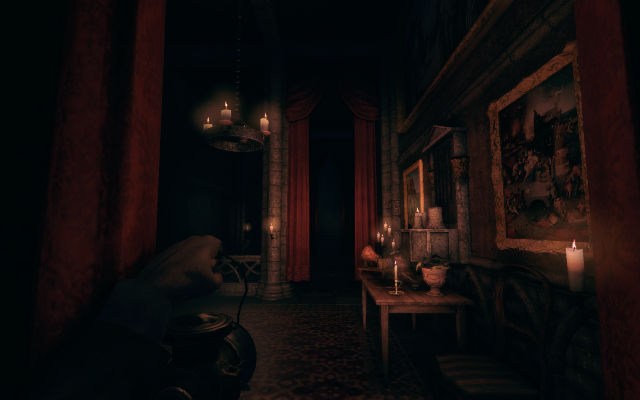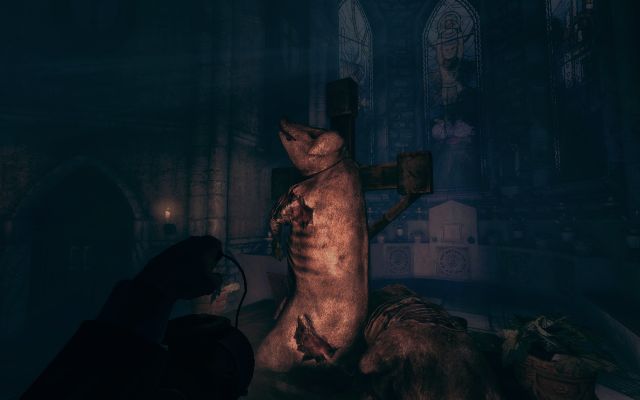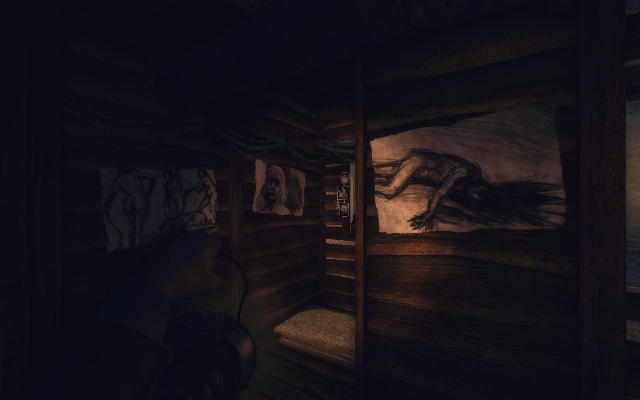Amnesia: The Dark Descent scared the sh*t out of me. No, really. And I’m the sort of a person who stomps on cheap trills and horrors as if they were an uncanny joke. It is NOT easy to scare me. It was ‘tension’, a tension not from monsters, but from absolutely nothing, that made The Dark Descent one of the most dreadful video games to ever hit the digital shelves. And so I head into the world of Amnesia: A Machine for Pigs, an indirect sequel of The Dark Descent, having a set of expectations. Does it live up to them? Read on to find out.
The year is 1899. You wake up in a Victorian furnished bedroom, lost and tense. You regain your focus and head out of the room, into a fabulous mansion, populated with magnificent paintings of Roman and Catholic art, gold lined doors and massive stairways. As breathtaking and spectacular this might sound, the mansion is equally sinister. Wooden creaks, echos, shrieks, all accompany you as you make your way forward. Dark and unassuming, the mansion gave me a flavour of what I was about to experience. TENSION. And this is how the game starts. “Alright!”, I say to myself enthusiastically, I like what I see.
My character is Oswald Mandus, who has as little an idea about himself as me, the player, has. He has one motive throughout the game, to find his children. Developed by The Chinese Room and published by Frictional Games, A Machine for Pigs is the journey Mandus takes to achieve this prime motive. It is on this journey that Mandus’ real character as well as other sub-plots are exposed. Most of the information comes from journals fetched, phone calls and voice logs.

The game stays true to its roots, offering unsettling atmospheres whilst staying away from living beings. Throughout the game, I was alone. Not a single living human soul was encountered. The game is ‘permanently’ dark. Barring a few mildly lit interiors, be assured that majority of your game time will be spent in darkness. Your only ally against the atmosphere is your infinite dim lit lamp.
After the first three hours of gameplay, I fathom that the game is building up to something BIG. There were glimpses of mild horror, terror and shock, but nothing materializing into the thing that makes you shudder in fright. The plot was slowly creeping upward on me, and so was the atmosphere. Mandus’ journey was becoming frantic and uncontrollable, and there was always this sensation that something is going to happen, I couldn’t describe what. I was just waiting for that moment. So I continued.
Once out of the mansion, you’ll be spending your time in a huge factory amongst pneumatic mechanisms, electrical generators, pistons and sewers, and a church too. No horror game is a horror game without a church. The level design is impeccable, and does well to achieve the game’s Victorian age setting. Only a minor part of the game takes place outdoors, and that for me was easily amongst the most forgettable moments in the game. Limited boundaries and no visual stimulation.

Journals can be found throughout your expedition. Journals are mostly diary entries and monologues left within the game environment, revealing details in a concealed and mysterious manner. I have to say, there is a very morbid, mysterious and dark tone to the language used in the journals. Some of the them had absolutely fascinating verses, which were equally frightening. A Machine for Pigs definitely has the goods when it comes to reading material.
The game’s progression strategy comes in the typical “Find X and Place in Y” format. There are no weapons, there is no map, there are no objectives. A Machine for Pigs has that organic flow to it, which I really dig. It’s intrusion free gaming. You move place A to place B, something happens, you solve a puzzle, and then you move to C. Backtracking barely exists in the game. Throughout my gameplay, I never needed to load from a previous save point, and I died only thrice. Twice was from mutated pigs (the only monsters in the game) who took a slash at me, and once was from falling in an electro-charged pool of sewer water.
As I progressed, most of the thrills begin to outgrow me. The perceived ‘build up’ was hung up somewhere, the voices of my character’s children became just voices, nothing else. The atmosphere became predictable. Yes, it did have some moments that’d spook me off guard, but that is only an ‘instant spook’ with no long term effects. The intended horror throughout the game never comes together as a whole. The sense of threat reduces as you near the ending of the game, and that is a bad thing, especially for a marketed ‘linear horror’ video game.

The entire campaign lasted a mere seven hours, which in my opinion is too short for a single video game package. Seven hours is just not enough time for a video game to have an influence on you, or inspire you. Isn’t that what we expect from video games, that they fulfill a need for us? I played A Machine for Pigs hoping it would give me sleepless nights and a ‘dark’ phase, but it left me feeling empty. No emotion at all. After completing a video game I always ask myself, how little/much did the game change me? I had no answer.
Relying almost entirely on its environment, A Machine for Pigs shows promise initially but fails to keep up with its own set standards. The linear organic approach is the only strong point in this game, and this is when the game is at its best, keeping it superfluous while being dark and disturbing. Yet the disturbia doesn’t have the wholesome effect as you’d like it to have. Its not a big deal, but it is a deal, nevertheless. I won’t hesitate from recommending this game to anyone, as the experience is unique, freaky and dark. Maybe a little shortlived though.
This game was reviewed on a Windows 8 PC with Nvidia GeForce GTX 770.







